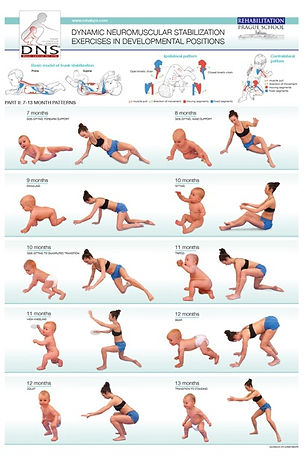EST. 2010
PHYSICAL MEDICINE & FUNCTIONAL REHAB
Dynamic Neuromuscular Stablization


Dynamic Neuromuscular Stabilization (DNS) is an innovative rehabilitation and performance system rooted in developmental kinesiology, integrating principles of motor control and the body’s innate movement patterns. Pioneered at the prestigious Prague School of Rehabilitation and Manual Medicine, DNS draws from groundbreaking research in human development and therapy techniques, particularly Vojta therapy. It has been refined through the work of renowned clinicians such as Dr. Václav Vojta, Dr. Vladimir Janda, and Dr. Pavel Kolar.
The Foundation: Prague School of Rehabilitation
The Prague School of Rehabilitation, housed within Charles University’s First Faculty of Medicine, has been a leader in rehabilitation medicine, advancing therapeutic techniques grounded in motor control and neurological development. The dynamic approach of DNS is one of its most impactful contributions, drawing inspiration from the reflexive patterns that develop in infancy and drive optimal human movement throughout life.
Vojta Therapy: A Foundation for DNS
DNS is built upon the principles of Vojta therapy, developed by Dr. Václav Vojta, a neurologist who discovered the significance of reflex locomotion—specific postural reactions and movement patterns elicited in infants that influence proper motor control. Vojta’s work highlighted how these primitive patterns are essential for developing optimal postural control, stabilization, and locomotion. DNS integrates these concepts to retrain the body to use ideal movement patterns, addressing dysfunctions at their neurological source.
Contributions of Dr. Vladimir Janda
Dr. Vladimir Janda, another luminary in rehabilitation medicine, emphasized the importance of the central nervous system’s role in movement patterns. He developed the concept of muscle imbalance, where dysfunctions in muscle tone lead to pain and movement limitations. Janda’s observations on postural control, movement synergies, and muscular imbalance complement the foundations of DNS, where correct postural activation plays a key role in functional stability.
The Evolution through Dr. Pavel Kolar
Dr. Pavel Kolar, a leading physiotherapist, advanced DNS by combining Vojta’s work with Janda’s insights into muscle imbalances. Dr. Kolar applied the principles of developmental kinesiology to understand the crucial role that postural reflexes and motor patterns from infancy play in adult movement. This understanding forms the basis of DNS techniques, which aim to restore these natural reflexes to correct movement dysfunction and improve overall stability.
Developmental Kinesiology and Reflex Locomotion
DNS is deeply rooted in the principles of developmental kinesiology. This science studies how infants develop movement patterns from reflexes and postural reactions to the coordinated, functional movements necessary for daily life. By observing how infants stabilize their core and coordinate their limbs through reflexive responses, DNS practitioners can restore these same patterns in adults.
Through a series of specific exercises, DNS retrains the brain and body to recognize these ideal motor patterns, allowing patients to achieve proper stabilization and strength during everyday movements. This therapeutic approach goes beyond traditional rehabilitation methods by focusing on how proper stabilization begins in the core and radiates outward to the limbs, improving functional movement and reducing the risk of injury.
DNS in Practice
DNS is used to treat a wide range of musculoskeletal disorders, from chronic pain to athletic injuries. It addresses issues of posture, muscle imbalances, and movement deficiencies by retraining the body’s motor control systems. This approach has been highly effective in improving core stability, enhancing athletic performance, and reducing the likelihood of future injuries.
Key benefits of DNS include:
Improved Core Stability: By focusing on the core as the center of movement control, DNS strengthens deep stabilizing muscles, supporting the spine and joints.
Enhanced Movement Efficiency: DNS helps patients achieve more efficient and coordinated movement patterns, improving overall physical function.
Injury Prevention: By restoring natural motor control, DNS reduces compensatory movement patterns that can lead to injury.
Why Choose DNS?
Dynamic Neuromuscular Stabilization is more than a rehabilitation technique; it’s a complete approach to understanding the body’s inherent movement systems. Whether recovering from an injury or seeking to enhance athletic performance, DNS offers a unique and scientifically backed method to retrain the body to move as it was designed to, improving stability, strength, and long-term function.
At River Forest Health and Wellness, we specialize in DNS techniques to help our patients regain control of their movement and optimize their physical health.
Treatable Conditions
The following conditions can be treated with DNS
-
Low back pain
-
Sciatica
-
Core weakness/instablity
-
Winging scapulas
-
Knee pain
-
Knocked knees
-
Toe walking
-
Meniscus tears
-
Ankle sprains
-
Plantar fasciitis
-
Bursitis
-
Hamstring sprains
-
Carpal tunnel
-
Tennis/golfer's elbow
-
Rotator cuff syndrome
-
Labrum tears
-
Disc herniations